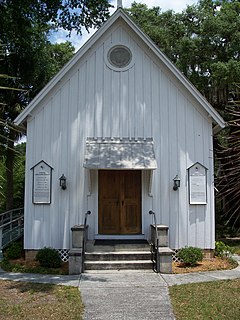
The Melrose Historic District is a 250-acre (100 ha) U.S. historic district in Melrose, Florida that was listed on the National Register of Historic Places in 1990. It is bounded by Seminole Ridge Road, Grove Street, South Street, Quail Street, and Melrose Bay. In 1990 it contained 65 contributing buildings and one contributing site, and 21 non-contributing buildings.

The University of Florida Campus Historic District is a historic district on the campus of the University of Florida in Gainesville, Florida. The district, bounded by West University Avenue, Southwest 13th Street, Stadium Road and Gale Lemerand Drive, encompasses approximately 650 acres (2.6 km2) and contains 11 listed buildings plus contributing properties. On April 20, 1989, it was added to the National Register of Historic Places. On June 24, 2008, additional information was approved which resulted in the addition of 6 contributing properties
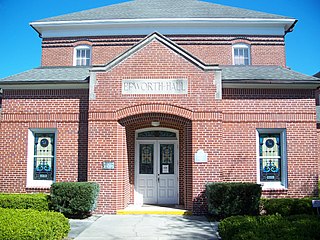
Epworth Hall is a historic building in Gainesville, Florida, United States. It is notable as one of the oldest surviving buildings associated with the University of Florida, though it is no longer part of the university's campus. It was erected in 1884 and is located at 419 Northeast 1st Street in downtown Gainesville. Now part of the First United Methodist Church, it was added to the U.S. National Register of Historic Places on July 25, 1973.

The John F. Seagle Building is a historic building located at 408 West University Avenue in Gainesville, Florida, in the United States. Built in 1926, it was designed by noted University of Florida architect and professor Rudolph Weaver and built by G. Lloyd Preacher & Company.

Anderson Hall is a historic building located in the northeastern section of the University of Florida campus in Gainesville, Florida. The building houses the university's political science and religion departments, both a part of the College of Liberal Arts and Sciences. Anderson Hall was designed by William Augustus Edwards, responsible for planning nearly all of the campus' early buildings, in Collegiate Gothic style. Construction began in 1912, and the building opened in October 1913 as Language Hall.
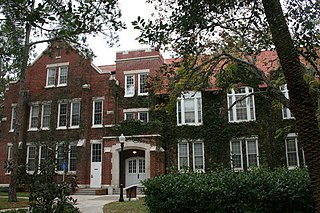
Bryan Hall is a historic building in Gainesville, Florida, United States. It is in the northeastern section of the University of Florida in Gainesville. On June 27, 1979, it was added to the U.S. National Register of Historic Places. Bryan Hall is part of the Warrington College of Business. The building also was home to the College of Law from 1914–1969.
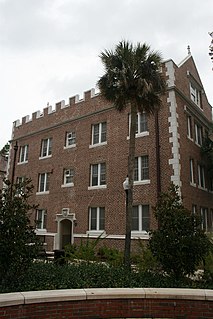
Buckman Hall is a historic building located in Murphree Area on the University of Florida campus in Gainesville, Florida, United States. It was designed by architect William A. Edwards in the Collegiate Gothic style and opened in 1906 as one of the two original buildings on the University of Florida's Gainesville campus along with nearby Thomas Hall. It once was a multi-purpose facility but has been used exclusively as a student dormitory since the 1940s.

Keene-Flint Hall is a historic site in Gainesville, Florida, United States. It is located in the northeastern section of the University of Florida. On June 27, 1979, it was added to the U.S. National Register of Historic Places. Keene-Flint Hall houses the University of Florida's History Department.
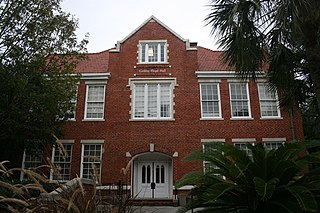
Griffin–Floyd Hall is a historic academic building located on the northeastern portion of the University of Florida campus in Gainesville, Florida. On June 27, 1979, it was added to the U.S. National Register of Historic Places. It currently houses the Department of Philosophy and Department of Statistics.

Newell Hall is a historic site in Gainesville, Florida, United States. It is located in the northeastern section of the University of Florida. On June 27, 1979, it was added to the U.S. National Register of Historic Places. Formerly home to the Department of Soil and Water Science, the building is currently used as a 24/7 study space for university students to collaborate.

Peabody Hall is a historic site in Gainesville, Florida, United States. It is located in the northeastern section of the University of Florida. On June 27, 1979, it was added to the U.S. National Register of Historic Places. It currently houses the Dean of Students Office and the Counseling Center at the university.

Thomas Hall, built in 1905, is a historic building located in Murphree Area on the campus of the University of Florida in Gainesville, Florida, United States. The building is named for William Reuben Thomas, the Gainesville mayor and businessman responsible for bringing the University of Florida to Gainesville.
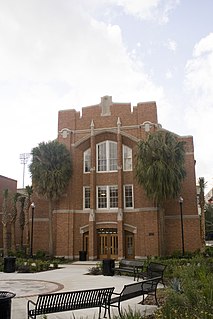
Kathryn Chicone Ustler Hall is a historic building on the campus of the University of Florida (UF) in Gainesville, Florida. It was designed by William Augustus Edwards in the Collegiate Gothic style and opened in 1919 as the University Gymnasium. In that capacity, the building was the first home of the Florida Gators men's basketball team, and it continued to serve as the home court for most of the university's indoor sports programs until the Florida Gymnasium opened in the late 1940s. The university became co-educational at about the same time, and the building was rechristened the Women's Gymnasium and was repurposed as a recreation center for the school's many new female students. On June 27, 1979, it was added to the U.S. National Register of Historic Places.
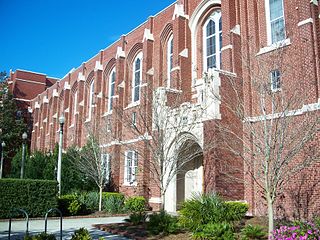
Library East is a historic library in Gainesville, Florida, United States. It is located in the northeastern section of the University of Florida in the middle of the Campus Historic District. When it was first created it was the largest building on campus at that time. It is a part of the George A. Smathers Libraries system and home to multiple collections of books and other library materials.

Norman Hall is an historic academic building on the eastern campus of the University of Florida in Gainesville, Florida. It was designed by architect Rudolph Weaver in the Collegiate Gothic style, and built in 1932. It originally housed the university's research and development primary and secondary schools, but now is the principal building of the university's College of Education. It is located on U.S. 441, near the southwest corner of S.W. 3rd Avenue and S.W. 12th Street in Gainesville. On January 26, 1990, it was added to the U.S. National Register of Historic Places.
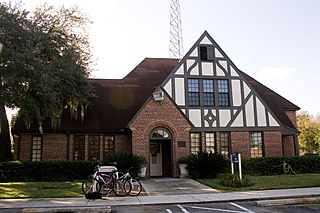
The Old WRUF Radio Station is a historic site in Gainesville, Florida, United States. It is located on the University of Florida campus. On September 21, 1989, it was added to the U.S. National Register of Historic Places.
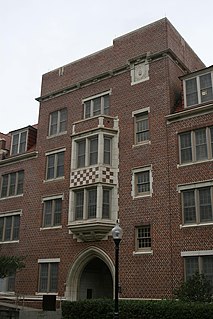
Fletcher Hall, originally called North Hall, is an historic dormitory building on the campus of the University of Florida in Gainesville, Florida, in the United States. It makes up half of the "F" in the "U.F." in the Murphee Area. The "U.F" in the building design can be seen from an aerial view. It was designed by Rudolph Weaver in the Collegiate Gothic style, was built in 1938 and was named for Duncan U. Fletcher, longtime U.S. Senator from Florida. It was renovated in 1984.

Sledd Hall is an historic student residence building in Murphree Area on the northern edge of the University of Florida campus in Gainesville, Florida. Built in 1929, the dormitory was designed by architect Rudolph Weaver in the Collegiate Gothic style. It is a contributing property in the University of Florida Campus Historic District.

The Plaza of the Americas is a major center of student activity on the campus of the University of Florida in Gainesville, Florida. It is located in the quad between Library West, Peabody Hall, the University Auditorium, and the Chemistry Building.

The history of the University of Florida is firmly tied to the history of public education in the state of Florida. The University of Florida originated as several distinct institutions that were consolidated to create a single state-supported university by the Buckman Act of 1905. The earliest of these was the East Florida Seminary, one of two seminaries of higher learning established by the Florida Legislature. The East Florida Seminary opened in Ocala 1853, becoming the first state-supported institution of higher learning in the state of Florida. As it is the oldest of the modern University of Florida's predecessor institutions, the school traces its founding date to that year. The East Florida Seminary closed its Ocala campus at the outbreak of the American Civil War and reopened in Gainesville in 1866
























